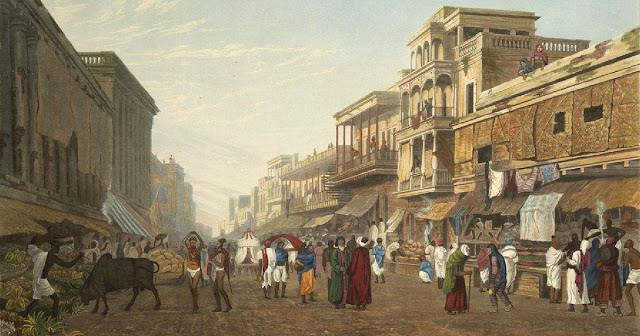Introduction: The Very First Civilizations on Earth
|| शुभारंभ ||
 |
| Figure: 2nd century BCE [600 BC] Ancient Indian Sage Maharishi "Kanada" studying Atomic Chemistry, Metaphysics, Physics, Philosophy, and Ethics. ॐ |
.jpg) |
| Figure: Dholavira - One of the largest Harappan civilization excavation sites during the Indus Valley Civilization peak periods established around 3500 BCE (India). |
 |
| Figure: An ancient medical text/scripture from thousands of years ago written in Sanskrit (India). |
 |
| Figure: World's First known scripture - The Rigveda: [author(s) multiple contributions]. |
There were some Vedic people or "Rishis" who used to live on the north pole and inhabited there during the warming periods on earth at the north pole (Uttara Kuru now called Siberia), observing the Aurora Borealis, and compiling their Natural Physics observations. Those people obviously moved back to the South during the Ice Age peaks. If there is a conflict of interest, or if, this statement seems False, or if it is doubtful that it is hard to live in the North Pole, read more about Wim Hof, who practices Pranayama - or breath control, to live in the Arctic region, Inspired by Vedic Science and Indian Culture.
 |
| Figure: Uttara Kuru [sanskrit] (Siberian Northern Lights). |
How we see people behaving today versus how the first ancient and more advanced civilizations on earth advanced and lived, there is an absolute disconnect between today and thousands of years ago! Shocking yet astonishing.
CIVILIZATION PREFACE AND SLAVERY DURING RECENT HISTORY:
There is a very popular English saying by George Orwell - quoted below:
"Who controls the past controls the future. Who controls the present controls the past." Well, that is not quite true. In fact, History, Science, Non-Science, Arts, Archeology, or Mathematics, these are logically and timelessly interconnected.
The Past is the collection of action(s) and information, which make up the history acknowledged in the present. However, manipulation of history has long been known to humans to display dominance and overpower the earlier or more resolved civilizations and belittle certain people or groups by newer civilizations. This is primarily done by people at more powerful stages than the exploited ones by different means, such as trade, imperialism, colonialism, divide, and rule/conquer. To give a decently solid example, let's pick Farming as an example of the settlement of a civilization. Farming and Agriculture in human history started around 15,000 years ago in Asia. Over centuries, the civilizations fulfilled their nutritional needs with different farming techniques. As the farming revolution took place all over the world, there was more demand and supply of crops, fruits, vegetables, meat, tobacco, etc. Sounds like humans are thriving and becoming more civil, isn't it?
No, not exactly! If we dive deeper into this demand of people, agriculture got commercialized and slavery intensified by more recent so-called "Royal" empires, organizations, or governments for capital gain.
 |
| Figure: A 17th-century Virginia-based tobacco wrapper by a Barnstaple, England based company displaying glorification of an enslaved African farmer (source/credit: encyclopediavirginia). |
 |
| Figure: A slave ship transporting African slaves around 1500s from Africa to Americas (source/credit: encyclopediavirginia). |
 |
| Figure: Aftermath of colonial exploitation of India - An Indian Slave Trade Market in 1800s Calcutta, India (source/credit: Scroll Magazine). |
INTRODUCTION TO THE CIVILIZATION:
The formation of a civilization is far before today's time. To understand and study a simple, yet astonishing early civilization, we would need to scale and fold the fourth dimension (time), to get to a starting point (considering Today/Present Day as an endpoint), sounds good? Let's go to the beginning of civilization during the Stone Age via your imagination! Take a look at the pictorial evidence below:
 |
| Figure: UNESCO World Heritage Site - 100,000 year old stone-age Bhimbetka rock shelters demonstrating rock paintings as old as 12,000 years ago(source/credit: Wikipedia). |
Well, people then had a good sense of intelligence and imagination to form a civilization. Humans traveled around the world to form civilizations. Around the same era, people formed the very first well-known civilization on the Indian Subcontinent popularly known as the Indus-Valley civilization originally known as Saraswati-Sindhu Sabhyatā [civilization]. Human beings initially traveled from East Africa developed the first Homosapien chromosomes, and then moved outwards, towards the present-day Middle East and the Indian subcontinent (an ancient name 'Bharat-Varsha') around 60,000 BC and settled to form one of the most advanced and well-constructed houses over the course of next thousands of years. Some branches traveled to other continents, like the South Europe-Asia region, the Americas, or the Russian subcontinent, which were connected via the Bering Strait (then Bridge) during the Ice Age, but most of them did not survive due to the Ice Age cold. The ones who survived and reached the Americas as first human beings are now called 'Native Americans'.
 |
| Figure: Bhimbetka Rock Shelters - present-day aerial view (source/credit: Google Maps) |
Fun Fact: The underground water drainage system around and under the Indus Valley river area of that era still exists, and is in a functional state to avoid floods. Shocking, right? Well, there is much more that can be discovered about the earliest civilization including the Vedic Period around the world.

Comments
Post a Comment